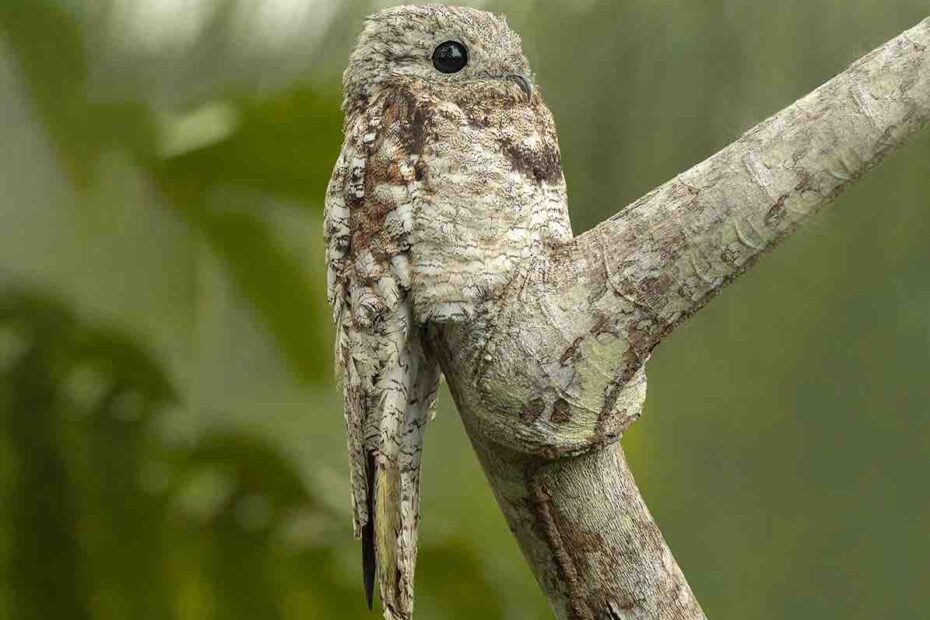In the dense canopies of the rainforests and the still of the night, there lurks a creature as enigmatic as it is elusive – the ghost bird potoo. Known for its haunting calls and ghostly appearance, the potoo has become a subject of folklore and fascination. Let’s unearth 10 intriguing facts about the ghost bird potoo that are sure to captivate and educate.
1. The Rare Appearance of the Ghost Bird Potoo
The ghost bird potoo is a master of disguise. With its cryptic plumage and eerie, wide-eyed stare, it blends seamlessly into the tree branches during the day. This camouflage is not just a defense mechanism but a unique adaptation that allows them to go virtually unnoticed in their natural habitat.
2. It’s Name Resonates With Its Aura
The name ‘potoo’ is derived from the Tupi language of Brazil and is onomatopoeic, mimicking the bird’s distinctive call. The ‘ghost bird’ part of their name reflects their nocturnal nature and their ability to disappear into their surroundings, much like a phantom.
3. It’s Not Just One, But Several Species
The term ‘ghost bird potoo’ actually refers to several species within the Nyctibius genus. Each species, from the Common Potoo to the Great Potoo, shares similar characteristics but varies slightly in size and habitat preferences.
4. It’s Got Unique Hunting Strategies
Potoos are nocturnal predators, adept at catching insects in mid-air. At night, they sally forth from their perches to snatch up moths, beetles, and other insects, using their large mouths to their advantage. This hunting strategy is both efficient and fascinating.
5. A Symphony in the Night: The Call of the Potoo
One of the most haunting aspects of the ghost bird potoo is its call. Described as a mournful wail, the potoo’s call can be heard echoing through the forests at night, adding to the mystique and lore surrounding these birds.
6. Elusive Potoo Is Not Available Everywhere
The ghost bird potoo is primarily found in the rainforests of Central and South America. Their range spans from Mexico down through Brazil, favoring forested regions where they can easily camouflage among the trees.
7. The Potoo’s Role in Local Folklore Is Different
In many cultures where the potoo is found, it has a significant place in folklore. Its eerie call and ghostly demeanor have led to various myths and legends, often portraying the potoo as a harbinger or a mystical creature of the night.
8. A Rare Glimpse: Spotting the Ghost Bird Potoo
Spotting a potoo in the wild is a rare and exciting experience. Birdwatchers and nature enthusiasts often seek out these elusive creatures, but their incredible camouflage makes them a challenging find. Knowing their distinctive call can be key to locating them.
9. It Has Uniqe Breeding and Nesting Habits
The ghost bird potoo has a unique approach to nesting. Instead of building a traditional nest, they lay a single egg in a depression on a tree branch. This minimalistic approach, combined with their excellent camouflage, helps protect their young from predators.
10. They Are Not Under Threats
While most potoo species are not currently considered endangered, they face threats from habitat loss and deforestation. Preserving their rainforest habitat is crucial for their survival, as well as for the myriad of other species that share their environment.
The ghost bird potoo is more than just a figure of myths and legends. It is a fascinating bird with unique adaptations that allow it to thrive in the rainforests of the Americas. From its haunting call to its incredible camouflage, the ghost bird potoo is a marvel of the avian world, reminding us of the mysteries and wonders that nature holds.
FAQs On Ghost Bird Potoo
- What exactly is a ghost bird potoo?
- The ghost bird potoo refers to a group of nocturnal birds within the Nyctibius genus, known for their distinctive and haunting calls and exceptional camouflage abilities. These birds are primarily found in the forests of Central and South America and are noted for their elusive, ghost-like presence.
- Why is the potoo called a ‘ghost bird’?
- The potoo is called a ‘ghost bird’ due to its ability to blend seamlessly with its surroundings and its haunting nocturnal calls. Its cryptic plumage allows it to mimic the appearance of tree bark, making it nearly invisible in its natural habitat during the day.
- Where can you find the ghost bird potoo?
- Ghost bird potoos are found in the dense rainforests of Central and South America, ranging from Mexico to Brazil. Their habitat preference includes areas rich in trees where they can easily camouflage and hunt for insects at night.
- What does the ghost bird potoo eat?
- The ghost bird potoo’s diet consists mainly of insects. At night, they catch flying insects like moths and beetles mid-air, using their large mouths. This nocturnal hunting behavior is a key aspect of their survival.
- How does the ghost bird potoo camouflage itself?
- The ghost bird potoo camouflages itself by adopting a posture that mimics the shape of a tree branch. Its feather patterns and coloration blend perfectly with the bark, making it nearly undetectable to predators and humans alike during the day.
- What is unique about the ghost bird potoo’s call?
- The call of the ghost bird potoo is unique and often described as mournful or wailing. These haunting sounds, typically heard at night, add to the bird’s mysterious aura and have become a subject of local folklore and myth.
Featured image courtesy: https://ebird.org/species/grepot1
